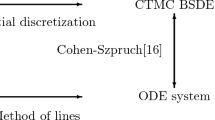Abstract
Part I of this research work is devoted to the development of a class of numerical solution algorithms for the filtering problem of Markov jump processes by indirect continuous-time observations corrupted by Wiener noises. The expected \({{\mathcal{L}}}_{1}\) norm of the estimation error is chosen as an optimality criterion. The noise intensity depends on the state being estimated. The numerical solution algorithms involve not the original continuous-time observations, but the ones discretized by time. A feature of the proposed algorithms is that they take into account the probability of several jumps in the estimated state on the time interval of discretization. The main results are the statements on the accuracy of the approximate solution of the filtering problem, depending on the number of jumps taken into account for the estimated state, on the discretization step, and on the numerical integration scheme applied. These statements provide a theoretical basis for the subsequent analysis of particular numerical schemes to implement the solution of the filtering problem.

Similar content being viewed by others
References
Wonham, W.Some Applications of Stochastic Differential Equations to Optimal Nonlinear Filtering, SIAM J. Control Optim., 1964, pp.347–369.
Rabiner, L. R. A Tutorial on Hidden Markov Models and Selected Applications in Speech Recognition. Proc.IEEE 77, 257–286 (1989).
Ephraim, Y. & Merhav, N. Hidden Markov Processes. IEEE Trans. Inform. Theory 48(no.6), 1518–1569 (2002).
Cappé, O., Moulines, E. & Ryden, T. Inference in Hidden Markov Models. (Springer, Berlin, 2005).
Elliott, R. J., Aggoun, L. & Moore, J. B. Hidden Markov Models: Estimation and Control. (Springer, New York, 2008).
Kloeden, P. & Platen, E. Numerical Solution of Stochastic Differential Equations. (Springer, Berlin, 1992).
Kahaner, D., Moler, C. & Nash, S. Numerical Methods and Software. (New Jersey, Prentice Hill, 1989).
Isaacson, E. & Keller, H. Analysis of Numerical Methods. (Dover, New York, 1994).
Stoer, J. & Bulirsch, R. Introduction to Numerical Analysis. (Springer, New York, 1993).
Kushner, H. J. Probability Methods for Approximations in Stochastic Control and for Elliptic Equations. (Academic, New York, 1977). Translated under the title Veroyatnostnye metody approksimatsii v stokhasticheskikh zadachakh upravleniya i teorii ellipticheskikh uravnenii, Moscow: Fizmatlit, 1985.
Kushner, H. & Dupuis, P. Numerical Methods for Stochastic Control Problems in Continuous Time. (Springer, New York, 2001).
Ito, K. & Rozovskii, B. Approximation of the Kushner Equation for Nonlinear Filtering. SIAM J.Control Optim. 38(no.3), 893–915 (2000).
Clark, J.The Design of Robust Approximations to the Stochastic Differential Equations of Nonlinear Filtering, Communication Systems and Random Process Theory, Skwirzynski, J.K., Ed., Amsterdam: Sijthoff and Noordhoff, 1978.
Malcolm, V., Elliott, R., and van der Hoek, J.On the Numerical Stability of Time-discretized State Estimation via Clark Transformations, Proc. 42nd IEEE Conf. Decis. Control, 2003, Maui, pp.1406–1412.
Yin, G., Zhang, Q. & Liu, Y. Discrete-time Approximation of Wonham Filters. J.Control Theory Appl. no.2, 1–10 (2004).
Platen, E. & Bruti-Liberati, N. Numerical Solution of Stochastic Differential Equations with Jumps in Finance. (Springer, Berlin, 2010).
Crisan, D., Kouritzin, M. & Xiong, J. Nonlinear Filtering with Signal Dependent Observation Noise. Electron. J. Probab. no.14, 1863–1883 (2009).
Dragan, V., Morozan, T. & Stoica, A. Mathematical Methods in Robust Control of Discrete-Time Linear StochasticSystems. (Springer, New York, 2010).
Dragan, V. & Aberkane, S. \({{\mathcal{H}}}_{2}\)-optimal Filtering for Continuous-time Periodic Linear Stochastic Systems with State-dependent Noise. Syst. Control Lett. no.66, 35–42 (2014).
Borisov, A. V. Wonham Filtering by Observations with Multiplicative Noises. Autom. Remote Control 79(no.1), 39–50 (2018).
Borisov, A. V. Application of Optimal Filtering Methods for On-Line Estimation of Queueing Network States. Autom. Remote Control 77(no.2), 277–296 (2016).
Huber, P. Robust Statistics. (Wiley, New York, 1981). Translated under the title Robastnost’ v statistike, Moscow: Mir, 1984.
Anderson, B. & Moore, J. Optimal Filtering. (Prentice Hill, New Jersey, 1979).
Takeuchi, Y. & Akashi, H. Least-squares State Estimation of Systems with State-dependent Observation Noise. Automatica 21(no.3), 303–313 (1985).
Borisov, A. V. Filtering of Markov Jump Processes by Discretized Observations. Inform. Primenen. 12(no.3), 115–121 (2018).
Bäuerle, N., Gilitschenski, I. & Hanebeck, U. Exact and Approximate Hidden Markov Chain Filters Based on Discrete Observations. Statist. Risk Modeling 32(no.3-4), 159–176 (2016).
James, M., Krishnamurthy, V. & LeGland, F. Time Discretization of Continuous-Time Filters and Smoothers for HMM Parameter Estimation. IEEE Trans. Autom. Control 42(no.2), 593–605 (1996).
Bertsekas, D. P. & Shreve, S. E. Stochastic Optimal Control: The Discrete-Time Case. (Academic, New York, 1978). Translated under the title Stokhasticheskoe optimal’noe upravlenie. Sluchai diskretnogo vremeni, Moscow: Fizmatlit, 1985.
R, Liptser, Sh. & Shiryaev, A. N. Statistika sluchainykh protsessov. 1st ed (Nauka, Moscow, 1974). Translated under the title Statistics of Random Processes I. General Theory, New York: Springer-Verlag, 1977.
Cvitanić, J., Liptser, R. & Rozovskii, B. A Filtering Approach to Tracking Volatility from Prices Observed at Random Times. Annals Appl. Probab. 16(no.3), 1633–1652 (2006).
Borovkov, A.A.Asimptoticheskie metody v teorii massovogo obsluzhivaniya, Moscow: Fizmatlit, 1995, 2nd ed. Translated under the title Asymptotic Methods in Queuing Theory (Probability & Mathematical Statistics), New York: Wiley, 1984, 1st ed.
Author information
Authors and Affiliations
Appendices
Appendix
Proof of Theorem 1. Using the notations Ξr ≜ ξ1ξ2…ξr and Θr ≜ θ1θ2…θr for the random matrices, together with the estimates \({\widehat{x}}_{r}\) and \({\overline{x}}_{r}(s)\), write the explicit-form expression
From Definition (4.2) it follows that \({\xi }_{q}^{kj}\leqslant {\theta }_{q}^{kj}\). Therefore, the matrix Θr − Ξr contains nonnegative elements only. For the sake of brevity, the dependence on r in Ξr and Θr will be omitted. The following chain of inequalities holds:
Consider the auxiliary estimate
According to the abstract form of Bayes’s rule,
and
From (A.1) and (A.2) it follows that, for r = 1 and for all π ∈ Π,
The process \({N}_{t}^{X}\) representing the total number of state jumps for Xt is a counting process, and its quadratic characteristic has the form
Therefore, the requisite probability can be estimated from above as
In combination with (A.3), this inequality implies \(\sigma (s)\leqslant 2{C}_{1}\frac{{(\overline{\lambda }h)}^{s+1}}{(s+1)!},\) i.e., the local accuracy estimate (4.7) is true.
The Markov property of the pair \(({X}_{t},{N}_{t}^{X})\) and (A.4) can be used for obtaining an upper bound for the probability \({\rm{P}}\left\{{\overline{a}}_{r}^{s}\right\}\) as well:
This result finally yields the global accuracy estimate (4.8). The proof of Theorem 1 is complete.
Proof of Theorem 2. Well,
Using the properties of matrix operations, write
Both estimates have stability, and consequently \(\parallel {\widetilde{x}}_{1}{\parallel }_{1}=\parallel {\overline{x}}_{1}{\parallel }_{1}=1\). The following chain of inequalities holds:
In combination with (5.7) and (A.7), this inequality leads to
The first inequality in (5.8) follows from the fact that the inequality above is valid for any π ∈ Π.
Define random matrices representing functions of ξr and ψr:
For proving Theorem 2, an auxiliary result will be needed.
Lemma 3
If \({\phi }_{r}\triangleq {\phi }_{r}({{\mathcal{Y}}}_{1},\ldots,{{\mathcal{Y}}}_{r})\) is a nonnegative \({{\mathcal{O}}}_{r}\)-measurable random variable and \({\Phi }_{r}\triangleq \frac{{\phi }_{r}}{{\bf{1}}{\Xi }_{1,r}^{\top }\pi }\), then
Proof of Lemma 3. Consider a nonnegative integrable function \({\phi }_{1}={\phi }_{1}(y):{{\mathbb{R}}}^{M}\to {{\mathbb{R}}}_{+}\) and an \({{\mathcal{O}}}_{1}\)-measurable random variable of the form
Find \({\rm{E}}\left\{{{\bf{I}}}_{{a}_{1}^{s}}(\omega ){\Phi }_{1}\right\}\):
Consider a nonnegative integrable function \({\phi }_{2}={\phi }_{1}({y}_{1},{y}_{2}):\,{{\mathbb{R}}}^{2M}\to {{\mathbb{R}}}_{+}\) and an \({{\mathcal{O}}}_{2}\)-measurable random variable of the form
Find \({\rm{E}}\left\{{{\bf{I}}}_{{A}_{2}^{s}}(\omega ){\Phi }_{2}\right\}\):
The general case \({\rm{E}}\left\{{{\bf{I}}}_{{A}_{r}^{s}}(\omega ){\Phi }_{r}\right\}\) is considered by analogy. The proof of Lemma 3 is complete.
Now estimate from above the norm of the error \({\Delta }_{r}={\widetilde{x}}_{r}-{\overline{x}}_{r}\). From the definition of the matrices Ξ, Ψ, and Γ it follows that
Performing transformations similar to those for Δ1, write
For estimating the contribution of each term in (A.9), take advantage of (A.5). For the sake of simplicity, consider the case r = 3, a function \(\phi ({y}_{1},{y}_{2},{y}_{3}):{{\mathbb{R}}}^{3M}\to {{\mathbb{R}}}_{+}\) of the form
and an O3-measurable random variable of the form
Estimate the following expression from above:
By analogy, it can be demonstrated that for an arbitrary r ⩾ 2,
This finally yields
the second inequality of (5.8) is immediate from the fact that the inequality above holds for any π ∈ Π.
The proof of Theorem 2 is complete.
Funding
This work was supported in part by the Russian Foundation for Basic Research, project no. 19-07-00187 A.
Rights and permissions
About this article
Cite this article
Borisov, A. \({{\mathcal{L}}}_{1}\)-Optimal Filtering of Markov Jump Processes. I. Exact Solution and Numerical Implementation Schemes. Autom Remote Control 81, 1945–1962 (2020). https://doi.org/10.1134/S0005117920110016
Received:
Revised:
Accepted:
Published:
Issue Date:
DOI: https://doi.org/10.1134/S0005117920110016




